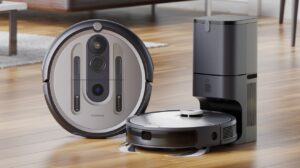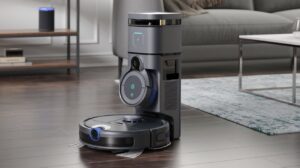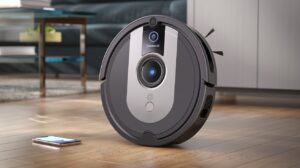AI and Smart Features in Robotic Vacuums: The Future of Home Cleaning
1. Introduction
Keeping a home spotless has always been a time-consuming chore, but advancements in technology are transforming how we approach cleanliness. Among the most revolutionary innovations are robotic vacuums. These smart devices have evolved far beyond basic cleaning tools into AI-powered marvels, capable of delivering efficient, intelligent, and hands-free cleaning solutions.
With features like smart navigation, voice control, and customizable cleaning schedules, robotic vacuums are becoming essential components of smart homes.
In this article, we’ll explore the evolution, benefits, and future of AI-powered robotic vacuums, offering insights into why they are a game-changer for modern households.

2. The Evolution of Robotic Vacuums
Robotic vacuums have come a long way since their introduction in the early 2000s. Initial models were limited in functionality, often moving randomly around a room, missing spots, and frequently getting stuck. However, the integration of AI and advanced sensors has revolutionized these devices.
Key Milestones in Their Evolution
- Basic Navigation: Early robotic vacuums relied on simple bump sensors for navigation, often cleaning inefficiently and missing many spots.
- Mapping Technology: The introduction of LiDAR and visual SLAM (Simultaneous Localization and Mapping) allowed robotic vacuums to create detailed maps of rooms. This breakthrough enabled systematic cleaning instead of random movement.
- AI Integration: With AI, robotic vacuums can now learn floor layouts, adapt to different environments, and optimize their cleaning patterns based on data collected from previous sessions.
These advancements have turned robotic vacuums from niche gadgets into indispensable cleaning assistants for millions of households worldwide.
3. How AI Powers Modern Robotic Vacuums
AI is at the core of what makes modern robotic vacuums smarter and more efficient. Let’s delve deeper into the technologies behind these innovations:
Machine Learning and Decision-Making
Robotic vacuums leverage machine learning algorithms to analyze data collected during cleaning sessions. This enables them to:
- Identify high-traffic areas that require extra attention.
- Learn optimal cleaning routes to minimize energy consumption and maximize coverage.
- Adapt to changes in the environment, such as new furniture placements or clutter.
Core AI Features
- Object Recognition and Obstacle Avoidance:
- Cameras and advanced sensors enable robotic vacuums to distinguish between objects like furniture, toys, cords, and pet bowls.
- This prevents interruptions during cleaning and reduces the risk of damage.
- Intelligent Navigation:
- AI allows vacuums to plan efficient cleaning paths and systematically cover every corner of a room. Unlike earlier models, modern robotic vacuums avoid redundant cleaning and missed spots.
- Room Mapping and Zoning:
- Advanced mapping technologies, such as LiDAR and visual SLAM, help robotic vacuums create detailed floor maps.
- Users can designate cleaning zones, such as “pet area” or “kitchen zone,” and mark areas to avoid.
4. Smart Features That Redefine Cleaning
Today’s robotic vacuums are equipped with a variety of smart features designed to make cleaning easier and more effective. Here are some of the most notable:
Voice Control and Integration
Modern robotic vacuums are compatible with popular smart home ecosystems, such as Amazon Alexa, Google Assistant, and Apple HomeKit. This allows users to control their devices using voice commands. Examples include:
- “Alexa, start cleaning the living room.”
- “Hey Google, send the vacuum back to its dock.”
This hands-free functionality enhances convenience, especially for busy households.
Customizable Cleaning Schedules
With user-friendly mobile apps, robotic vacuums allow homeowners to create personalized cleaning schedules. Features include:
- Setting specific times for cleaning sessions.
- Selecting rooms or zones to prioritize.
- Adjusting suction power or cleaning modes for different surfaces.
Multi-user functionality also ensures that everyone in the household can contribute to managing cleaning schedules.
Self-Emptying and Maintenance Automation
Advanced models feature self-emptying dustbins that can hold debris for several weeks, reducing the frequency of manual maintenance. These models also:
- Notify users when filters or brushes need cleaning or replacement.
- Perform self-diagnostics to identify and report potential issues.
Pet-Friendly Features
For pet owners, robotic vacuums offer specialized modes for tackling pet hair and dander. Additional features include:
- Tangle-free brush rolls designed to handle fur without clogging.
- HEPA filters that trap allergens, improving air quality.
- Silent cleaning modes that minimize noise, keeping pets comfortable.
Energy Efficiency and Eco-Friendliness
AI-powered vacuums optimize power usage by adjusting suction levels based on the type of surface being cleaned. Eco-friendly modes reduce energy consumption, aligning with the sustainability goals of environmentally conscious consumers.

5. Benefits of AI and Smart Features in Everyday Life
Time-Saving Convenience
Robotic vacuums are perfect for busy professionals, parents, and individuals who want to spend less time on household chores. With automated schedules and intelligent navigation, these devices clean efficiently while you focus on other priorities.
Enhanced Cleaning Quality
AI-driven mapping and object recognition ensure thorough cleaning, even in hard-to-reach areas. Unlike traditional vacuums, robotic models adapt their cleaning techniques to suit different surfaces and environments.
Seamless Smart Home Integration
As part of a smart home ecosystem, robotic vacuums integrate with devices like thermostats, lights, and security systems. For example:
- Vacuums can start cleaning when you leave the house, using geofencing technology.
- Integration with security cameras allows vacuums to double as mobile surveillance units.
Accessibility for All
These devices are particularly beneficial for individuals with mobility challenges, offering effortless cleaning without the need for physical exertion.
6. Choosing the Right AI-Powered Robotic Vacuum
Selecting the perfect robotic vacuum depends on your specific needs and preferences. Here are some factors to consider:
Home Layout and Floor Types
- Homes with multiple rooms or levels benefit from models with advanced mapping and multi-floor memory.
- For carpeted floors, look for vacuums with strong suction power and specialized brush rolls.
- Hardwood and tile floors require models with soft brushes and gentle cleaning modes.
Budget and Long-Term Value
- High-End Models: Offer features like self-emptying, advanced AI, and superior cleaning performance. Examples include iRobot Roomba s9+ and Roborock S7 MaxV Ultra.
- Mid-Range Options: Provide excellent cleaning capabilities at a more affordable price. Consider models like the Eufy RoboVac series.
- Budget-Friendly Choices: Basic models with essential features, suitable for smaller homes or less frequent use.
Lifestyle Considerations
- Pet Owners: Choose models with pet-specific cleaning modes and allergen-reducing HEPA filters.
- Tech Enthusiasts: Opt for vacuums with app control, voice integration, and IoT connectivity.
- Families: Look for durable models that can handle high-traffic areas and frequent messes.
7. Limitations and Challenges
While robotic vacuums offer numerous benefits, they are not without their limitations:
Initial Cost
High-end robotic vacuums can be expensive, ranging from $500 to $1,500. While the investment pays off in convenience, the upfront cost may be a barrier for some consumers.
Dependence on Connectivity
Many smart features rely on Wi-Fi connectivity. In areas with unreliable internet, these features may not function optimally.
Privacy Concerns
AI-powered vacuums equipped with cameras and microphones may raise concerns about data privacy. Manufacturers must address these issues with transparent data policies and secure systems.
Maintenance Requirements
Despite automation, robotic vacuums still require periodic maintenance, such as emptying the dustbin, cleaning brushes, and replacing filters.
8. The Future of AI in Robotic Vacuums
The future of robotic vacuums is brimming with exciting possibilities. Innovations in AI and IoT will continue to enhance their functionality:
Emerging Trends
- Predictive Cleaning: AI will predict cleaning needs based on household activity patterns and seasonal changes.
- Advanced Multi-Room Adaptation: Vacuums will become even more adept at navigating complex layouts and multi-level homes.
Deeper IoT Integration
As IoT technology advances, robotic vacuums will integrate seamlessly with other smart home devices, creating a unified ecosystem. Examples include:
- Coordination with smart thermostats to clean while HVAC systems are off.
- Integration with voice assistants for even more intuitive control.
Improved Efficiency and Sustainability
Future models will focus on energy efficiency, faster charging, and more durable batteries. Additionally, manufacturers may incorporate recyclable materials to align with eco-friendly initiatives.

9. Real-Life Use Cases and Testimonials
Real-world examples highlight the impact of robotic vacuums:
- Families with Kids: “Our robotic vacuum saves us so much time cleaning up after our kids. It even avoids their toys!”
- Pet Owners: “It’s a lifesaver for managing pet hair and dander. Our floors have never been cleaner.”
- Busy Professionals: “I love coming home to a clean house. The app integration makes it so easy to schedule cleanings while I’m at work.”
10. Conclusion
AI-powered robotic vacuums are revolutionizing home cleaning. With features like intelligent navigation, voice control, and self-maintenance, these devices offer unparalleled convenience and efficiency. While initial costs and maintenance requirements exist, the long-term benefits far outweigh the drawbacks.
If you’re ready to embrace the future of home cleaning, explore the latest models and find the perfect fit for your lifestyle. With AI and smart features, keeping your home spotless has never been easier!





